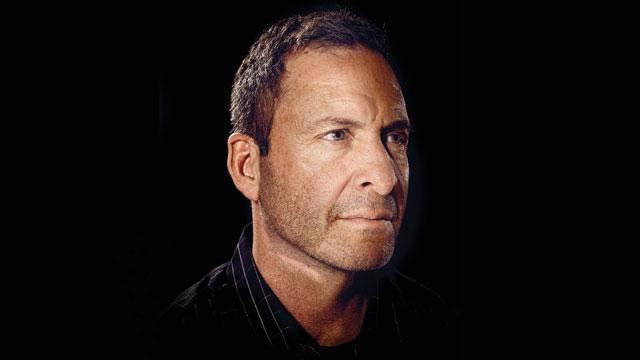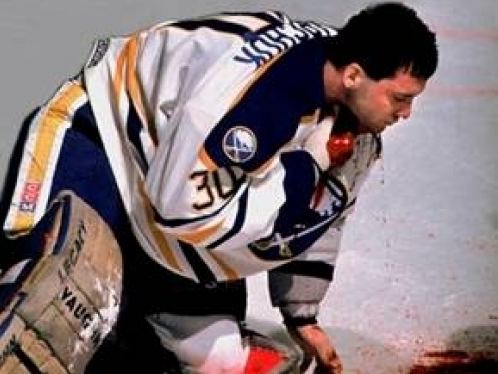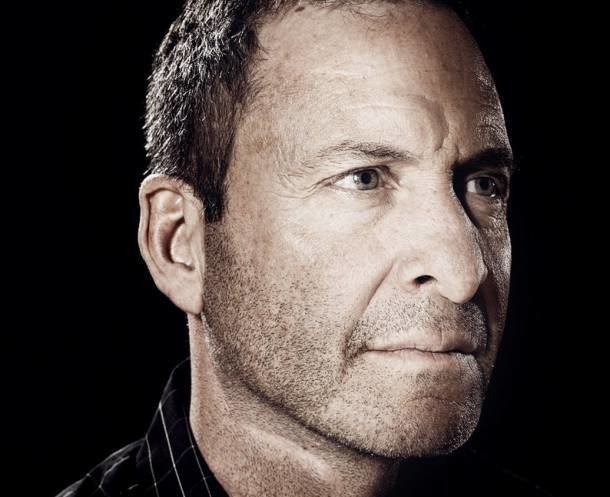Height 6 ft 1 in (185 cm) Name Clint Malarchuk Career end 1996 Playing career Career start 1981 | Caught Left Weight 84 kg Role Coach | |
 | ||
NHL Draft 74th overall, 1981Quebec Nordiques Spouse Joan Alissa Goodley (m. 2006), Sandra L. Malarchuk, Christy Lynn Canatsey Similar People Daren Puppa, Richard Zednik, Steve Tuttle, Joe Theismann, Bill Masterton | ||
Clint malarchuk speakers spotlight showcase 2015
Clint Malarchuk (born May 1, 1961) is a retired Canadian professional ice hockey goaltender who played in the National Hockey League (NHL) between 1981 and 1992. He has been a coach for four NHL teams and two minor league teams, most recently the Calgary Flames. He was born in Grande Prairie, Alberta, raised in Edmonton, Alberta, and lives in Alberta and Nevada.
Contents
- Clint malarchuk speakers spotlight showcase 2015
- Clint Malarchuk Accident
- Playing career
- Neck injury
- Minor pro career
- Coaching career
- Gun incident
- Personal life
- References

Malarchuk is best known for having survived a life-threatening injury during a 1989 NHL game when Steve Tuttle's skate blade sliced his carotid artery and jugular vein, causing immediate massive blood loss.

Clint Malarchuk Accident
Playing career

Malarchuk played junior hockey for the Portland Winter Hawks of the Western Hockey League (WHL). He then went on to play professionally in the National Hockey League (NHL) for the Quebec Nordiques, Washington Capitals, and Buffalo Sabres, and in the International Hockey League (IHL) for the San Diego Gulls and Las Vegas Thunder. He had a career record of 141 wins, 130 losses, 45 ties, 12 shutouts, and an .885 save percentage.
Neck injury

During a game on March 22, 1989, between the visiting St. Louis Blues and Malarchuk's Buffalo Sabres, Steve Tuttle of the Blues and Uwe Krupp of the Sabres crashed hard into the goal crease during play. As they collided, Tuttle's skate blade hit the right front side of Malarchuk's neck, severing his carotid artery and injuring the surrounding carotid sheath and jugular vein.

With blood spurting from Malarchuk's neck onto the ice, he was able to leave the ice on his own feet with the assistance of his team's athletic trainer, Jim Pizzutelli. Many spectators were physically sickened by the sight. The excessive amount of blood caused eleven fans to faint, two more to suffer heart attacks and three players to vomit on the ice. Local television cameras covering the game cut away from the sight of Malarchuk bleeding after noticing what had happened, and Sabres announcers Ted Darling and Mike Robitaille were audibly shaken. At the production room of the national cable sports highlight show, a producer scrolled his tape back to show the event to two other producers, who were both horrified by the sight.

Malarchuk, meanwhile, believed he was going to die. "All I wanted to do was get off the ice", said Malarchuk. "My mother was watching the game on TV, and I didn't want her to see me die." Aware that his mother had been watching the game on TV, he had an equipment manager call and tell her he loved her. Then he asked for a priest.
Malarchuk's life was saved due to quick action by the team's athletic trainer, Jim Pizzutelli, a former Army combat engineer who served in Vietnam. He gripped Malarchuk's neck and pinched off the blood vessel, not letting go until doctors arrived to begin stabilizing the wound. The team doctor led the pair off the ice then applied extreme pressure by kneeling on his collarbone—a procedure designed to produce a low breathing rate and low metabolic state, which is preferable to exsanguination. Previous reports have suggested doctors worked for hours to save Malarchuk's life, however this is an overestimate. He was conscious and talking on the way to the hospital (Malarchuk jokingly asked paramedics if they could bring him back in time for the third period). The game resumed when league personnel received word that the player was in stable condition.
Malarchuk lost 1.5 litres of blood. It took doctors a total of 300 stitches to close the six-inch wound. He was back on the ice in ten days.
Malarchuk's performance declined over the next few years, until he decided to leave the NHL. After this, he struggled with obsessive-compulsive disorder (as he had since a young age), as well as nightmares and alcoholism, but he remained in pro hockey in the International Hockey League. After retiring as a player, Malarchuk continued as a coach.
On February 10, 2008, coincidentally again in Buffalo, Florida Panthers forward Richard Zedník suffered an injury similar to Malarchuk after Olli Jokinen's skate blade cut the front of Zedník's neck, injuring his external carotid artery, causing immediate massive blood loss. Although he initially refused to view the footage, upon viewing it Malarchuk was taken aback, saying that he didn't think his memory of his own incident would come back after 19 years. He sought treatment for post-traumatic stress disorder the following year.
Minor pro career
In 1992-93, Malarchuk was a goaltender for the IHL's San Diego Gulls and played in the league championship. The following Season he became starting goaltender for the Las Vegas Thunder, appearing in 56 games and accumulating a record of 34-10-7. He was later hired as the team's head coach and assistant GM. His jersey number was retired by the Thunder and hangs from the rafters of the Thomas & Mack Center.
Coaching career
Malarchuk served as head coach of the IHL Las Vegas Thunder in the 1998-99 season and the Idaho Steelheads until 2000. Afterwards he was a goaltending coach for the NHL Florida Panthers during the 2002-03 season. He was signed as the goaltending coach for 2006–07 by the Columbus Blue Jackets. In August 2010 Malarchuk agreed to become the goaltending consultant for the Atlanta Thrashers. On June 17, 2011, Calgary Flames announced hiring Malarchuk as their goaltender coach. On June 17, 2014, the Calgary Flames announced they parted ways with Malarchuk and were searching for a new goaltending coach. He had earlier taken leave during the 2013-14 season to enter the National Hockey League's substance abuse treatment program.
Gun incident
On October 7, 2008, Malarchuk suffered what, according to his wife, Joan, was a self-inflicted gunshot wound to his chin from a .22 caliber rifle at his residence in Fish Springs, Nevada after a period of stress and domestic problems. The incident was initially described as an accident while hunting rabbits, but both the goalie and his wife have since admitted it was a suicide attempt. On October 10, 2008, The Douglas County, Nevada sheriff's investigation concluded the shooting was accidental under suspicious circumstances, but afterwards Joan Malarchuk said she unequivocally told the sheriff it was a suicide attempt "so that he would get the help he needed".
Officers and paramedics at the scene reported that Malarchuk, who was bleeding from both his mouth and chin, was uncooperative and refused treatment. Joan Malarchuk said she sat with her husband and comforted him because she was afraid he would lash out again and get shot by police. Malarchuk was later flown to Renown Regional Medical Center in Reno for treatment and released less than a week after the shooting. He then spent approximately 6 months in a rehab hospital being treated for alcoholism, obsessive-compulsive disorder, and post-traumatic stress disorder.
The Canadian Press reported that Joan informed authorities that her husband was not supposed to consume alcohol as he was on prescription medications for obsessive-compulsive disorder, but was doing so anyway at the time of the shooting. Malarchuk later said he believed he was overmedicated dating back to when he was prescribed an anti-psychotic sedative while playing pro hockey in San Diego.
Personal life
After his playing career Malarchuk settled on a ranch near Las Vegas, Nevada (later Gardnerville, Nevada) where he and his wife at the time raised three kids. In mid 2000, he became certified as a veterinary technician and runs a practice as a horse dentist from his ranch. Malarchuk is of Ukrainian descent.
A visiting photographer once had his camera flash stolen by Clint Malarchuk's emus.
His nickname in hockey was "the Cowboy Goalie" because he was active in the Calgary, Alberta-area rodeo scene during the hockey off-season. He was depicted riding bareback in a front-page newspaper photo while playing for the Washington Capitals, and he was later given horses as a contractual bonus with the Las Vegas Thunder. He also credited his cowboy upbringing for his toughness when returning to play for the Buffalo Sabres.
Malarchuk released an autobiography called The Crazy Game in November 2014. In the United States the book was published with the title A Matter of Inches—How I Survived In The Crease And Beyond. The book appeared on the Toronto Star bestsellers list through January 2015. and was made into a documentary film.
Following its release, Clint and Joan Malarchuk were public speakers about topics covered in the book such as obsessive-compulsive disorder, support for alcoholics in recovery, suicide prevention, and psychological trauma. On May 7, 2015, Malarchuk was a guest speaker at a Canadian Mental Health Association meeting in Oakville, Ontario. On August 1, 2015, Clint and Joan Malarchuk were keynote speakers at the International OCD Foundation conference in Boston, Massachusetts. They showed the video footage of his sports injury to the audience with the advice that it is potentially triggering to people who are uncomfortable with images of blood and trauma.
